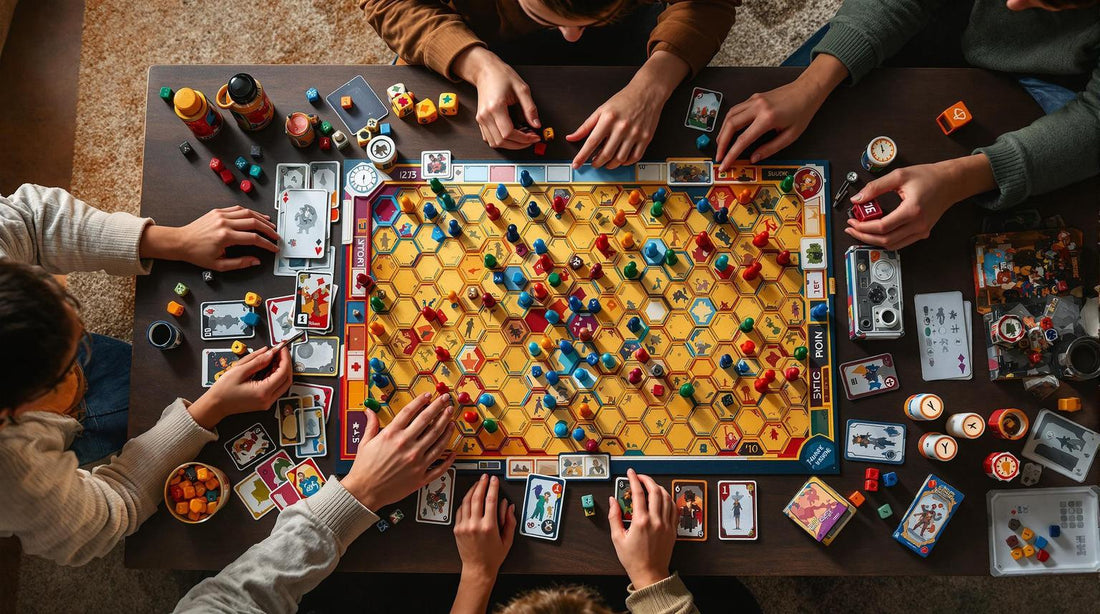Discover the Best Board Games for Every Player

Turn vs Round vs Phase: Key Differences
Understanding turns, rounds, and phases is essential for mastering tabletop games. Here's a quick breakdown:
- Turns: A single player's opportunity to act. For example, in Catan, you gather resources, trade, and build during your turn.
- Rounds: A complete cycle where every player takes their turn. In Monopoly, a round ends after all players have gone once.
- Phases: Smaller segments within turns or rounds, guiding specific actions. For instance, Warhammer 40K divides turns into phases like Command, Movement, and Shooting.
Quick Comparison
| Element | Definition | Example Games | Key Purpose |
|---|---|---|---|
| Turn | One player's actions | Catan, Risk | Focused decision-making |
| Round | All players completing their turns | Monopoly, D&D | Equal participation, progression |
| Phase | Subsections of turns or rounds | Warhammer 40K, Risk | Adds structure and strategy |
Turn Order Systems in Tabletop Games
1. Player Turns
Let's dive into how player turns work in gameplay. A turn is the time when a player gets to plan and make their moves. During this time, they follow a set sequence of actions and decisions.
Most games structure player turns to reflect their design. For example, in Catan, a player's turn involves gathering resources, trading, and building. This step-by-step process helps players focus on specific tasks while strategizing.
In more intricate games like Warhammer 40K, turns are divided into distinct phases:
| Phase | Purpose |
|---|---|
| Command | Planning strategy and activating abilities |
| Movement | Shifting units across the battlefield |
| Shooting | Carrying out ranged attacks |
| Charge | Starting close combat |
| Fight | Resolving melee battles |
Player turns are crucial for strategic thinking and interaction. In Power Grid, some phases, like turn order and auctions, involve all players. This approach keeps everyone engaged, even when it's not their turn, tying individual moves into the game's overall flow.
Here are some important aspects of player turns:
- Action Economy: Balancing the number of actions a player can take
- Turn Duration: Keeping turns short enough to avoid long waits
- Decision Depth: Providing meaningful choices without overwhelming players
Modern games aim for turns that are both concise and engaging. This approach keeps the game moving and avoids players getting stuck overthinking their moves.
Next, let's see how these individual turns come together to form game rounds.
2. Game Rounds
Rounds bring structure to gameplay by grouping individual turns into full cycles. While turns focus on what each player does, rounds tie everything together, setting the overall rhythm of the game.
Take Monopoly, for example. A round is complete when every player has taken their turn. Some modern tabletop games add more complexity, splitting rounds into distinct segments to allow for varied actions and strategies.
In BattleTech, rounds are divided into phases where both sides act at the same time. This simultaneous play keeps downtime short and players engaged.
In Risk, rounds take on greater importance as the game progresses. Rewards increase over time, naturally pushing the game toward its climax.
Dungeons & Dragons introduces reaction mechanics, letting players respond to events outside of their turn. This keeps everyone involved and invested throughout the round.
Well-crafted rounds do more than just organize turns - they shape the flow of the game. In The Settlers of Catan, rounds encourage trading and resource collection, fostering interaction while maintaining a competitive balance. Up next, we’ll dive into how these rounds are broken into specific phases to fine-tune the gameplay experience.
sbb-itb-1ed942f
3. Round Phases
Phases break rounds into structured segments, guiding player actions and ensuring a smooth flow of gameplay.
Take Agricola as an example. It uses a three-part round structure: "Upkeep", "Replenishing", and "Work" phases, with a recurring "Harvest" phase. This setup helps players manage their farming tasks step by step, keeping the process clear and organized.
The complexity of these phases can vary widely. For instance, Warhammer 40,000 uses a detailed phase system to separate tactical decisions, ensuring clarity during gameplay.
Some games use phases to introduce unique strategic layers. In Power Grid, not every phase requires participation from all players. For example, the auction phase involves only those bidding on power plants, showing how phases can adapt to different gameplay needs.
Similarly, BattleTech divides its actions into distinct phases - movement, shooting, and assault - ensuring each step is clear and manageable:
| Phase | Purpose | Player Involvement |
|---|---|---|
| Movement | Positioning of units | Sequential |
| Shooting | Resolving ranged attacks | Sequential |
| Assault | Engaging in close combat | Sequential |
In Apex Legends: The Board Game, a Transition Phase manages cooldowns and card draws, acting as a checkpoint to maintain balance and pacing.
Well-designed phases bring structure and rhythm to gameplay, helping players focus their decisions while keeping them engaged.
Benefits and Limitations
Looking at the strengths and weaknesses of different gameplay mechanics helps us understand their role in game design. This understanding is useful for both players and designers.
Turns give players clear control and the chance to make focused decisions. Many classic games use turns to simplify gameplay, letting players concentrate on their own strategies. However, in larger groups, turns can lead to downtime while waiting for others.
Rounds ensure everyone participates equally and provide natural progression points. For example, in Risk, rounds bring fresh resources and opportunities. That said, they can feel repetitive if not designed with enough variety.
Phases break down complex actions into smaller, structured steps, adding strategic depth. But this structure can also make games more complicated and harder to learn.
| Element | Benefits | Limitations | Best Used For |
|---|---|---|---|
| Turns | Clear player control, focused decisions, easy to follow | Downtime for others, limited interaction between turns | Games with deep, individual strategies |
| Rounds | Equal participation, structured progression, balanced gameplay | Risk of repetition, artificial pacing | Games needing balanced involvement across players |
| Phases | Organized steps, deeper strategy, clear structure | Can be complex, harder to learn, potential for confusion | Games with intricate actions that need structure |
Designers often mix these mechanics to balance their strengths and weaknesses. For instance, Warhammer 40,000 uses a five-phase system to keep complexity manageable while maintaining clarity.
Experts agree that well-designed turns can boost player engagement and reduce downtime. To tackle downtime further, many modern games now include simultaneous actions, keeping things structured but faster-paced.
Summary
Understanding turns, rounds, and phases is key to mastering tabletop game mechanics. Each plays a distinct role in shaping a structured and enjoyable gaming experience. Here's a quick recap of the main ideas.
Turns give players dedicated time for their actions, either in order or simultaneously, ensuring the game flows smoothly. Rounds provide a cycle where everyone gets a chance to act, marking clear points of progression once all players have completed their moves.
Phases break down complex actions into smaller, easier-to-handle steps. Many modern games, like Agricola, use this approach. For instance, phases such as Upkeep, Replenishing, and Work help players focus on specific tasks while keeping the game moving forward.
By blending these mechanics, tabletop games create an environment where players can:
- Concentrate on strategic choices
- Clearly follow game progress
- Stay actively involved throughout
- Manage timing and resources effectively
This thoughtful design creates a steady rhythm, making gameplay engaging while keeping the structure easy to follow. Together, these elements highlight the careful planning behind successful tabletop games.
FAQs
Here are answers to some frequently asked questions about the timing mechanics in games.
What is the difference between a turn and a round?
A turn is the time when one player gets to act, while a round includes a full cycle where every player has taken their turn. This keeps the game organized and ensures everyone gets an equal chance to play.
How do phases work in gameplay?
Phases divide turns or rounds into smaller, structured parts for specific actions. For example, in Warhammer 40K, each turn has five phases: Command, Movement, Shooting, Charge, and Fight. These phases happen in order, guiding the flow of the game.
Which games use unique turn structures?
BattleTech uses a different approach, splitting each round into phases where both sides act during every phase. This setup allows for simultaneous actions and reactions, adding more strategy and realism.
How do different turn structures affect game flow?
Turn structures shape how the game feels and flows. For instance, Agricola uses a three-phase turn system (Upkeep, Replenishing, and Work) to create a steady pace. On the other hand, Catan includes phases for resource collection and trading, encouraging more interaction between players.
Can rounds and phases overlap?
Yes, in some games, phases can exist within larger rounds, creating a layered mechanic. This adds complexity and strategy while still keeping the game structured and easy to follow.
Grasping these timing mechanics can help you better understand game strategies and make the most of your gameplay experience.






